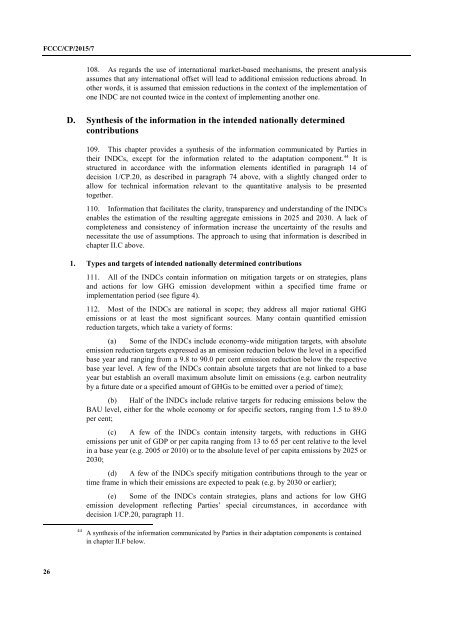FCCC/CP/2015/7
1PYuHQM
1PYuHQM
Create successful ePaper yourself
Turn your PDF publications into a flip-book with our unique Google optimized e-Paper software.
<strong>FCCC</strong>/<strong>CP</strong>/<strong>2015</strong>/7<br />
108. As regards the use of international market-based mechanisms, the present analysis<br />
assumes that any international offset will lead to additional emission reductions abroad. In<br />
other words, it is assumed that emission reductions in the context of the implementation of<br />
one INDC are not counted twice in the context of implementing another one.<br />
D. Synthesis of the information in the intended nationally determined<br />
contributions<br />
109. This chapter provides a synthesis of the information communicated by Parties in<br />
their INDCs, except for the information related to the adaptation component. 44 It is<br />
structured in accordance with the information elements identified in paragraph 14 of<br />
decision 1/<strong>CP</strong>.20, as described in paragraph 74 above, with a slightly changed order to<br />
allow for technical information relevant to the quantitative analysis to be presented<br />
together.<br />
110. Information that facilitates the clarity, transparency and understanding of the INDCs<br />
enables the estimation of the resulting aggregate emissions in 2025 and 2030. A lack of<br />
completeness and consistency of information increase the uncertainty of the results and<br />
necessitate the use of assumptions. The approach to using that information is described in<br />
chapter II.C above.<br />
1. Types and targets of intended nationally determined contributions<br />
111. All of the INDCs contain information on mitigation targets or on strategies, plans<br />
and actions for low GHG emission development within a specified time frame or<br />
implementation period (see figure 4).<br />
112. Most of the INDCs are national in scope; they address all major national GHG<br />
emissions or at least the most significant sources. Many contain quantified emission<br />
reduction targets, which take a variety of forms:<br />
(a) Some of the INDCs include economy-wide mitigation targets, with absolute<br />
emission reduction targets expressed as an emission reduction below the level in a specified<br />
base year and ranging from a 9.8 to 90.0 per cent emission reduction below the respective<br />
base year level. A few of the INDCs contain absolute targets that are not linked to a base<br />
year but establish an overall maximum absolute limit on emissions (e.g. carbon neutrality<br />
by a future date or a specified amount of GHGs to be emitted over a period of time);<br />
(b) Half of the INDCs include relative targets for reducing emissions below the<br />
BAU level, either for the whole economy or for specific sectors, ranging from 1.5 to 89.0<br />
per cent;<br />
(c) A few of the INDCs contain intensity targets, with reductions in GHG<br />
emissions per unit of GDP or per capita ranging from 13 to 65 per cent relative to the level<br />
in a base year (e.g. 2005 or 2010) or to the absolute level of per capita emissions by 2025 or<br />
2030;<br />
(d) A few of the INDCs specify mitigation contributions through to the year or<br />
time frame in which their emissions are expected to peak (e.g. by 2030 or earlier);<br />
(e) Some of the INDCs contain strategies, plans and actions for low GHG<br />
emission development reflecting Parties’ special circumstances, in accordance with<br />
decision 1/<strong>CP</strong>.20, paragraph 11.<br />
44 A synthesis of the information communicated by Parties in their adaptation components is contained<br />
in chapter II.F below.<br />
26


